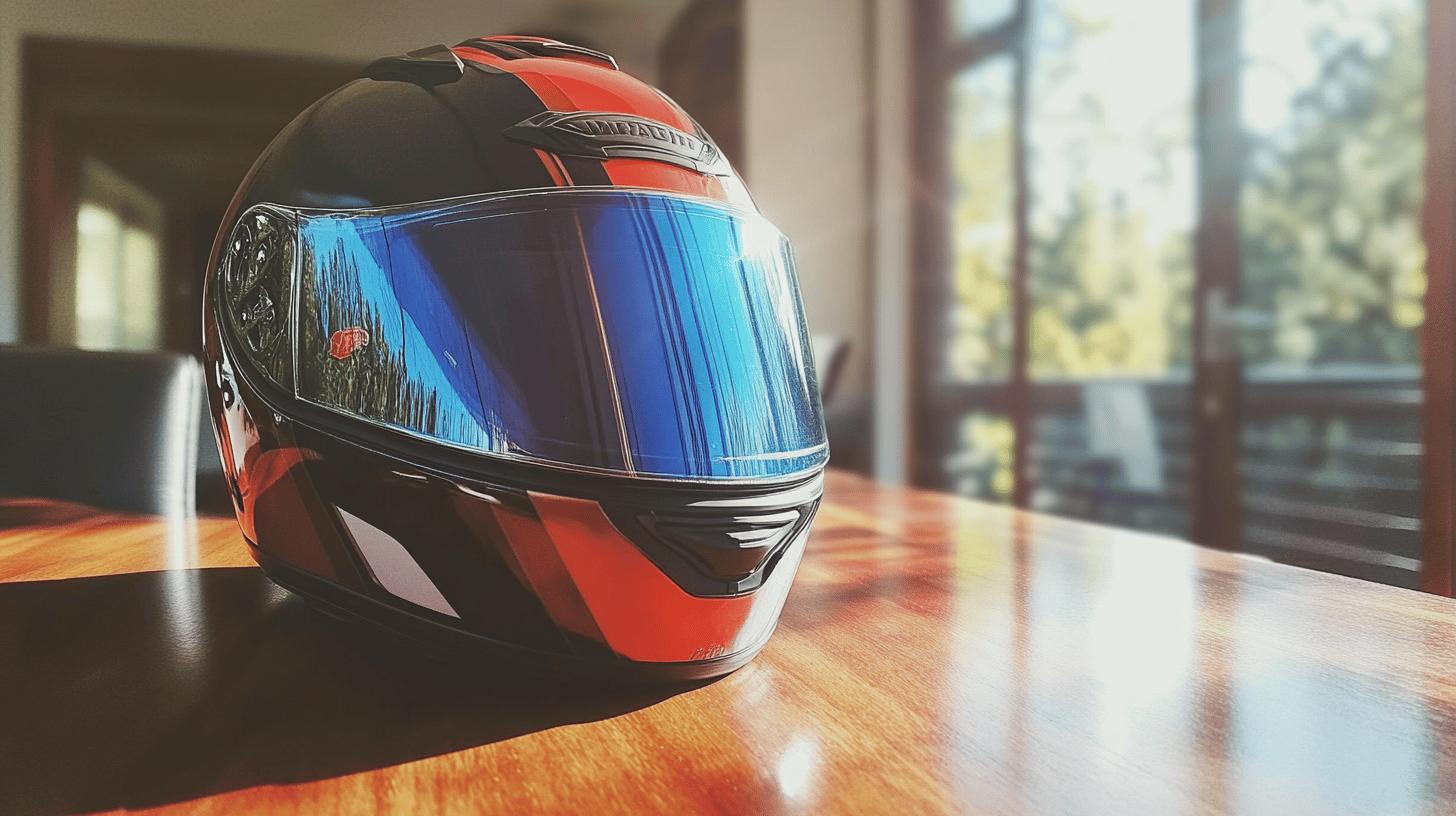Ever thought about adding a sleek, tinted visor to your motorcycle helmet for glare reduction while hitting the road? Tinted visors enhance aesthetics and reduce sunlight glare, providing a distinct riding advantage.
While they promise a stylish upgrade to your riding gear, they also introduce challenges, especially when night falls. Balancing style with safety can be complex, but it’s achievable with the right approach.
In this article, Mark Anderson from Protective Gearz guides you through safely tinting your motorcycle helmet visor, ensuring both enhanced style and optimal visibility, no matter the time of day. Let's ride safe and stylish!
Understanding the Benefits and Challenges of Tinted Visors

Tinted visors offer several benefits for motorcycle riders, primarily in glare reduction and aesthetic enhancement. The tint helps to minimize the harsh sunlight, which can be distracting and impair vision on the road.
By reducing glare, riders can maintain better focus and comfort during daytime riding. From a style perspective, tinted visors add a sleek and modern look to helmets, appealing to those who want to personalize their riding gear. Furthermore, some tints are designed to block harmful UV rays, contributing to eye health over extended periods of riding.
Challenges arise with tinted visors, particularly concerning night-time visibility. The reduced light transmission can significantly impair a rider's ability to see clearly in low-light conditions, increasing the risk of accidents. Riders typically need to switch to a clear visor for night rides or carry an additional visor to swap when necessary.
An alternative solution is using High-Intensity Discharge (HID) lights, which can enhance road visibility at night. However, reliance on tinted visors at night should be approached with caution and proper preparation to avoid compromising safety.
Key benefits and challenges of tinted visors include:
-
Glare Reduction: Minimizes sunlight glare, improving daytime visibility.
-
Aesthetic Appeal: Enhances the visual style of the helmet.
-
UV Protection: Shields eyes from harmful ultraviolet rays.
-
Night Vision Impairment: Reduces visibility in low-light conditions.
-
Additional Equipment Needed: May require HID lights or an alternate visor for safe night-time riding.
Essential Tools and Materials for DIY Visor Tinting

Having the right tools and materials is crucial for a successful DIY visor tinting project. Proper equipment ensures a smooth application and minimizes the risk of damaging the visor. A well-prepared workspace and high-quality materials are essential to achieve a professional-looking finish.
Using static cling film provides the advantage of an easily removable option, allowing riders to adjust the tint based on lighting conditions. This flexibility can be particularly beneficial for those who frequently transition between day and night riding.
Below is a list of essential tools and materials needed for DIY visor tinting:
-
Tint Film: Choose a high-quality film designed for visors to ensure durability and clarity.
-
Static Cling Film: Offers a removable option for those who prefer flexibility in tint application.
-
Squeegee: Essential for smoothing out the film and removing air bubbles during application.
-
Precision Knife: Necessary for trimming the film to fit the visor perfectly without leaving jagged edges.
-
Cleaning Materials: Use a soft cloth and a non-abrasive cleaner to prepare the visor surface before application.
-
Spray Bottle: Filled with soapy water to help position the film and make adjustments before final adhesion.
Step-by-Step Guide: How to Tint Your Motorcycle Helmet Visor

Proper preparation is crucial when tinting your motorcycle helmet visor safely. Begin by removing the visor from the helmet to avoid any accidental damage. Clean the visor thoroughly with a soft cloth and non-abrasive cleaner to eliminate dirt and grease, which can prevent the tint film from adhering properly.
Measure the visor to determine the size of the tint film needed, ensuring precision in cutting and application. Accurate measurement helps prevent waste and ensures a snug fit without overhangs that could peel away during use.
-
Cut the Tint Film: Use your measurements to cut the film slightly larger than the visor. This extra margin allows for precise trimming after application.
-
Prepare the Surface: Spray a light mist of soapy water on the visor. This creates a slippery surface that makes it easier to adjust the film during application.
-
Apply the Tint Film: Carefully align the film with the visor's edge and lay it down, starting from one side and working your way to the other. Use a squeegee to smooth out the film, pushing from the center outwards to remove air bubbles.
-
Trim the Excess: Once the film is positioned correctly, use a precision knife to trim away the excess film, leaving a clean edge that matches the visor's shape.
-
Secure the Edges: Run the squeegee along the edges to ensure the film adheres firmly, preventing peeling or lifting during use.
-
Check for Bubbles: Inspect the visor for any remaining bubbles. If found, gently lift the film in that area, reapply soapy water, and use the squeegee to smooth it out again.
After the tint film is applied, it’s important to focus on finishing touches and addressing potential issues. Allow the visor to cure for at least 24 hours before reattaching it to the helmet to ensure the adhesive sets properly. If adhesive residue affects visibility, clean it with a gentle solution designed for plastic surfaces.
Troubleshoot common problems such as persistent bubbles by using a sharp needle to puncture and release trapped air, resealing with the squeegee. Proper maintenance will prolong the life of your tinted visor and maintain clarity during rides.
Legal and Safety Considerations for Visor Tinting

Understanding the legal restrictions on visor tinting is crucial for motorcycle riders to avoid fines and ensure compliance with safety regulations. Each state in the United States has its own regulations regarding the permissible level of tint on helmet visors.
Exceeding these legal limits can result not only in penalties but also in reduced visibility, which compromises safety. Riders must familiarize themselves with local laws and adjust their visor tint accordingly. Legal compliance ensures that the visor provides adequate visibility in varying light conditions, essential for rider safety.
| State | Legal Tint Restrictions |
|---|---|
| California | No tint allowed on the visor during night rides; daytime tint must allow at least 50% light transmission. |
| Texas | Tint must allow at least 25% light transmission at all times. |
| Florida | Visors can be tinted during daylight, but a clear visor is required for night-time riding. |
Adhering to helmet safety standards is equally important as following legal restrictions. These standards ensure that visors maintain sufficient visibility and structural integrity to protect the rider. Non-compliance can not only lead to legal issues but also increase the risk of accidents due to impaired vision.
Ensuring the chosen tint meets safety guidelines without compromising on visibility is critical. Riders should select tints that comply with both legal and safety standards, balancing aesthetic preferences with practical functionality for safe riding experiences.
Tips for Maintaining and Using Your Tinted Visor

Regular maintenance of a tinted visor is crucial for ensuring its longevity and optimal performance. Cleaning the visor with mild solutions keeps it free from dirt and grime, which can obstruct vision and scratch the tint. A gentle approach is essential—harsh chemicals and abrasive materials can damage the tint film.
Consistent upkeep not only maintains the aesthetic appeal but also ensures that the visor continues to provide effective glare reduction and UV protection. Integration with other protective gear is equally important; a properly maintained visor should seamlessly align with a rider's helmet and other safety equipment for maximum efficiency.
-
Use Mild Cleaning Solutions: Opt for non-abrasive cleaners to avoid scratching the tint.
-
Check Compatibility with Gear: Ensure the visor's tint does not interfere with helmet fit or other equipment.
-
Handle with Care: Avoid dropping or placing the visor on rough surfaces.
-
Store Safely: Keep the visor in a protective case when not in use to prevent damage.
-
Regular Inspections: Check for signs of wear or peeling, addressing any issues promptly.
Applying protective coatings can further enhance the visor's durability by preventing scratches that mar visibility. These coatings act as a barrier against the elements and rough handling, extending the life of the visor.
By incorporating these practices, riders can maintain the clarity and functionality of their tinted visors, ensuring they remain a reliable component of their motorcycle gear.
Final Words
Embarking on the journey of tinting your motorcycle helmet visor involves understanding its benefits, gathering essential tools, and navigating legalities. Tinting reduces glare but poses night visibility challenges.
Having proper tools ensures success, while abiding by legal standards guarantees safety compliance. Learning how to tint your motorcycle helmet visor requires careful application to avoid issues like bubbles.
Regular maintenance extends its lifespan, ensuring a safer, more stylish ride. Enjoy the enhanced aesthetics and protection responsibly.
FAQ
Can a motorcycle helmet visor be tinted?
A motorcycle helmet visor can be tinted to reduce glare and enhance aesthetics. However, it's crucial to consider safety aspects, especially the impact on visibility during low-light conditions.
Is it legal to tint a helmet visor?
The legality of tinted helmet visors varies by state. Riders should check local regulations, as exceeding tint restrictions can lead to fines and compromised safety standards.
How to put window tint on a visor?
To apply window tint to a visor, clean the surface, measure and cut the film, adhere it carefully to avoid bubbles, and trim excess material. Proper application ensures clear visibility and adherence to safety standards.
Are dark helmet visors legal?
Dark helmet visors may not be legal everywhere due to visibility concerns. Riders should verify legal tint levels in their state and consider alternative tint options that meet safety requirements.

Ryan Thompson is a 35-year-old sport bike enthusiast known for his adventurous spirit. With years of weekend rides and exploring new roads, Ryan brings fresh insights and firsthand experience to ProtectiveGearz. His energetic approach and passion for the latest gear make him a trusted source for riders seeking up-to-date advice.



